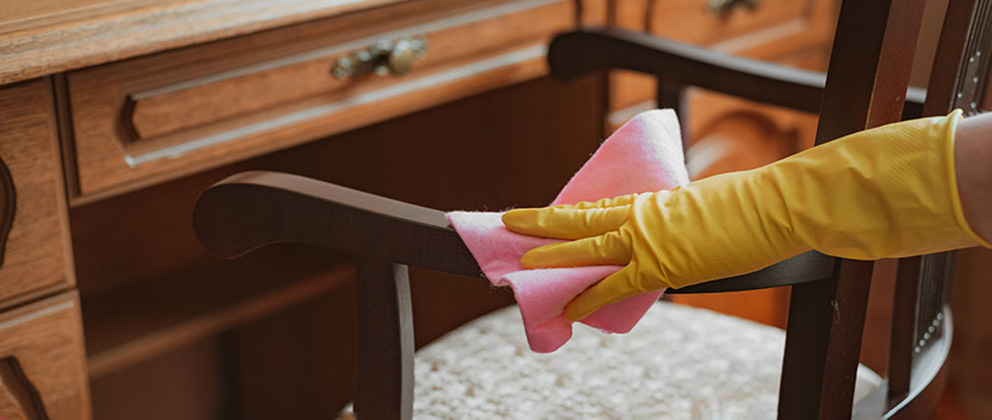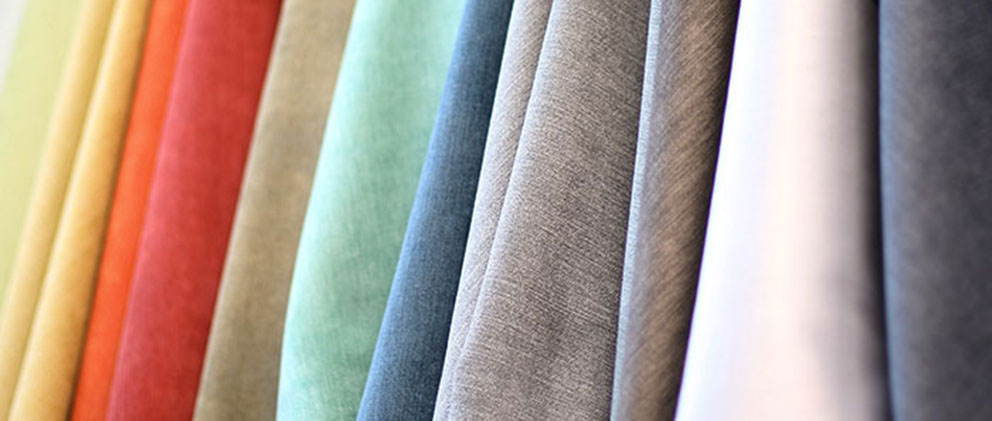Keep your chairs looking good as new and your customers safe from the spread of germs
Chairs require regular maintenance and cleaning to maintain the appearance of surfaces and upholstery. It’s also important to disinfect in order to help stop the spread of germs.
This blog will walk you through the best ways to clean different types of chair frames and upholstery.
Maintenance of Wooden Chairs
Cleaning Wooden Chairs
Wood furniture should be cleaned, wiped down, and sanitized regularly to maintain the luster. It’s important to take extra precautions with wooden furniture since harsh cleaners may ruin the finish. Also, regularly dust wooden chair frames with a soft duster that will not scratch the surface.
For general cleaning, we recommend using a mild solution of soap and water applied with a damp, soft, nonabrasive cloth. Dry the wood immediately because leaving water on the wood for an extended period might damage the finish.
Disinfecting Wooden Chairs
The World Health Organization recommends using bleach for disinfecting surfaces. It is safe to use bleach to disinfect Holsag wooden chair frames if done so properly. An approximate mixture of 1-part bleach (5% sodium Hypochlorite) and 9-parts water should we applied with a soft cloth. After application, be sure to clean off all the bleach solution with a damp rag and then dry completely.
You can also use a cleaner called Virox (see product directions). Virox is a hydrogen peroxide-based disinfectant that is less harmful to the user, the chair surface, and the environment than other disinfectants. This product is commonly used in healthcare facilities.
Additionally, you can purchase cleaners that are specially formulated for wood, however; make sure you read the labels carefully to see if it’s an appropriate cleaner to use on a lacquer finish, which is what is used on all Holsag wooden chairs. The use of abrasive cleaners may void the frame warranty.

A few additional tips:
- Do not allow water, chemicals (detergents, vinegar, ammonia, etc.) or other food spills to set on the surface.
- Always wipe up spills as soon as possible so they will not damage the surface.
- For food spots/water spots use a soft cloth to wipe the surface.
- Avoid using coarse or abrasive cloths as they may dull or scratch the surface. Never use soap pads, nylon or scouring pads of any kind.
- Never use harsh cleaning solvents such as mineral spirits, paint thinner, or alcohol.
- For greasy oily spots, as well as waxy spots like lipstick and crayons, use an environmentally approved / non-ammoniated natural cleaner, such as Green Works.
- Do not wax or polish the finished surface. Wax build-up may leave a residue that is hard to remove. Most polishes contain silicones that will contaminate the finished surface.
Maintenance of Faux Wood Chairs
Cleaning Faux Wood Chairs
Faux wood chair frames are manufactured with aluminum that is powder-coated, and then a grain transfer paper is applied to the frame to produce the look of a finished wood grain. It’s best to wash these frames with a soft sponge or rag and a solution of mild soap and water. Rinse with water and let dry. You can also use Soft Scrub® to remove scuff marks and scratches.
Although lemon oil and automotive paste wax can be used on some aluminum frames, avoid using these with faux wood because it can disrupt the texture of the finish.
Disinfecting Faux Wood Chairs
Bleach can be used for disinfecting the surfaces of Holsag faux wood chairs. An approximate mixture of 1-part bleach (5% sodium Hypochlorite) and 9-parts water should we applied with a soft cloth. After application, clean off all the bleach solution with a damp rag and then dry completely.
You can also use another cleaner recommended for faux wood, if it’s not abrasive because that can erode some powder-coated finishes.
Cleaning Vinyl and Polyurethane Upholstery
If your chairs have a vinyl cushion, use a gentle mixture of any mild soap and warm water to dissipate the most common soil from the surface. Wash the cushion using a soft cloth. If stubborn dirt remains, such as a stain imbedded in the grain, use a soft brush.
To disinfect and remove difficult stains, use a touch of cleaning powder or bleach and clean water.
The best way to clean and disinfect polyurethane upholstery is to use a solution of bleach and clean water. Use one teaspoon of bleach for every one gallon of water. Make sure to measure carefully as stronger concentrations can damage the material. Apply the solution with a damp rag.
In both situations, rinse and dry the cushion’s fabric with a soft cloth.

Cleaning Fabric Upholstery
Cleaning fabric upholstery can be complicated. We’ll lay it out for you here and walk you through everything from a light cleaning to disinfecting.
Light Fabric Cleaning
Day-to-day cleaning and light maintenance will keep your chairs looking nice while picking up dust and airborne debris. The best items to use for these tasks are lint rollers and vacuums.
Lint Rollers
Lint rollers are great for quick cleaning after events and meetings. They can pick up hairs, dirt, and other fibers. The advantage of using a lint roller, as compared to most fabric brushes, is that the sticky paper lifts the fabric, rather than flattening it and rubbing dirt into the weaves of the fabric. Pushing dirt into the fabric fibers is eventually what dulls the color and leaves the furniture looking worn.
Vacuum
Though it is not necessary to vacuum every day, doing a light run every week, using nozzle attachments, will help reduce built-up grime.
Fabric Washing
It’s a good idea to give furniture a routine rinse every so often. A light lather can reverse regular wear and uplift small, set-in debris from the woven fabric.
Chairs upholstered with fabric treated with a performance treatment—such as Nanotex, InCase, Crypton, iClean, or Alta—will generally clean nicely. In fact, you may notice a brighter color and a better general aesthetic to the fabric after cleaning.
However, a fabric made using cotton, polyester, nylon, and wool (or a mixture of these yarns) that is not treated with a performance treatment will be more difficult to clean, especially if the material is stained. It also may not brighten after general cleaning.
Something else to note, Scotchguard and Teflon are not performance treatments. These formulas are sprayed onto a material versus an actual performance treatment, such as those mentioned above, which encapsulate the yarn in a process where the material is immersed in a liquid bath. This is why it’s important to have chair fabric treated at the time of purchase.
To disinfect fabric, particularly fabric that is 100% polyolefin, use a bleach solution to sanitize the material.

Precautions When Cleaning
Although cleaning your chairs regularly is important, use as little liquid as possible. This will help keep your fabric looking better for longer. Using too much water can leave visible watermarks or soak the upholstery and cause the fabric to lose its integrity (it can shrink or sag).
Also, avoid water contact with the metal parts of the chair, particularly any zippers around the seat cushions, as they can rust if not dried thoroughly.
Before washing, check the labels or fabric code on the back of furniture items as some fabrics will be damaged by the presence of water. If your label says, “dry clean only”, it will need to be professionally cleaned.
To ensure your chairs and furniture are water safe, test a small area on a single item and wait a few hours to see if the water affects the fabric.
How to Create a Disinfecting Solution
Make a solution by mixing ¼ cup dishwashing liquid with 1 cup of warm water. With an electric hand mixer, whisk the solution until a dense layer of thick, dry suds forms across the top.
Use a clean cloth to gently massage the suds into the fabric, being careful not to rub, as rubbing will work the dirt and germs deeper into the woven fabric fibers. Pressing hard, use a rubber cooking spatula to scrape away the dirty suds. Rinse, by dabbing the washed area with a warm, damp cloth.
Always allow the fabric or furniture to thoroughly dry before use, as moisture will cause more dirt to cling to the chair’s surface.
Deep Cleaning, Sanitizing, and Removing Set-In Stains
Stains, immediate or set in, are always tricky to remove from chair upholstery. There’s a chance the simple soap and water method shown above could do the trick. However, sometimes the fabric needs stronger disinfecting and heavier cleaning to remove stains.
Here are some measures you can take.
Steam Cleaning
Steam, unlike straight water, has moisturizing properties that will hydrate a stain without saturating it completely with liquid. Once a stain is moisturized, it may loosen from the fibers and become easier to blot out. Using a steam vacuum is the easiest way to do this. However, putting a standard iron with a steam setting over the spot may do the trick as well.
Vinegar
Vinegar has natural solvent properties that may help loosen and lift set-in stains. Apply vinegar to upholstery with a damp, clean rag and blot over the desired area. Then, take a second towel to soak up any remaining fluid and grime.
Though vinegar has an odor, the smell will evaporate after the chair is completely dry.
Cleansers*
If the above methods don’t work, try a commercial-grade fabric cleansing spray to disinfect the materials. These products contain solvents that chemically attack set-in stains and germs. Some of our favorites are:
- Resolve Stain Remover
- Tuff Stuff Multi-Purpose Foam Cleanser
- Folex Stain Remover
- BISSELL Spot & Stain Fabric and Upholstery Cleaner
Never rub in the solution as rubbing can deepen the stain and fray the fabric fibers causing more damage to your furniture.
Stain & Spot Removal for Upholstered Chairs
This does not constitute an endorsement for any specific product. Ajax is a registered trademark of Colgate Palmolive Co. Energine is a registered trademark of Sterling Drug Co. Carbona is a registered trademark of Carbona Products Co.
One Final Note
Remember to store your chairs in an environment that is safe and free of grime. This will increase the amount of time between necessary cleanings.